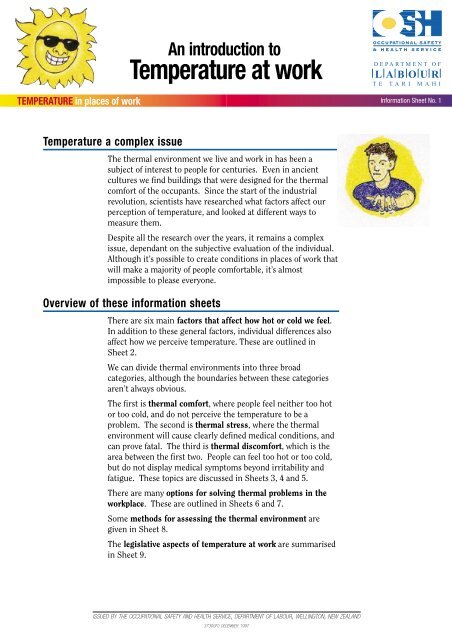Temperature in Places of Work - Health and Safety - Department of ...
Temperature in Places of Work - Health and Safety - Department of ...
Temperature in Places of Work - Health and Safety - Department of ...
You also want an ePaper? Increase the reach of your titles
YUMPU automatically turns print PDFs into web optimized ePapers that Google loves.
TEMPERATURE <strong>in</strong> places <strong>of</strong> work<br />
<strong>Temperature</strong> a complex issue<br />
An <strong>in</strong>troduction to<br />
<strong>Temperature</strong> at work<br />
The thermal environment we live <strong>and</strong> work <strong>in</strong> has been a<br />
subject <strong>of</strong> <strong>in</strong>terest to people for centuries. Even <strong>in</strong> ancient<br />
cultures we f<strong>in</strong>d build<strong>in</strong>gs that were designed for the thermal<br />
comfort <strong>of</strong> the occupants. S<strong>in</strong>ce the start <strong>of</strong> the <strong>in</strong>dustrial<br />
revolution, scientists have researched what factors affect our<br />
perception <strong>of</strong> temperature, <strong>and</strong> looked at different ways to<br />
measure them.<br />
Despite all the research over the years, it rema<strong>in</strong>s a complex<br />
issue, dependant on the subjective evaluation <strong>of</strong> the <strong>in</strong>dividual.<br />
Although it’s possible to create conditions <strong>in</strong> places <strong>of</strong> work that<br />
will make a majority <strong>of</strong> people comfortable, it’s almost<br />
impossible to please everyone.<br />
Overview <strong>of</strong> these <strong>in</strong>formation sheets<br />
There are six ma<strong>in</strong> factors that affect how hot or cold we feel.<br />
In addition to these general factors, <strong>in</strong>dividual differences also<br />
affect how we perceive temperature. These are outl<strong>in</strong>ed <strong>in</strong><br />
Sheet 2.<br />
We can divide thermal environments <strong>in</strong>to three broad<br />
categories, although the boundaries between these categories<br />
aren’t always obvious.<br />
The first is thermal comfort, where people feel neither too hot<br />
or too cold, <strong>and</strong> do not perceive the temperature to be a<br />
problem. The second is thermal stress, where the thermal<br />
environment will cause clearly def<strong>in</strong>ed medical conditions, <strong>and</strong><br />
can prove fatal. The third is thermal discomfort, which is the<br />
area between the first two. People can feel too hot or too cold,<br />
but do not display medical symptoms beyond irritability <strong>and</strong><br />
fatigue. These topics are discussed <strong>in</strong> Sheets 3, 4 <strong>and</strong> 5.<br />
There are many options for solv<strong>in</strong>g thermal problems <strong>in</strong> the<br />
workplace. These are outl<strong>in</strong>ed <strong>in</strong> Sheets 6 <strong>and</strong> 7.<br />
Some methods for assess<strong>in</strong>g the thermal environment are<br />
given <strong>in</strong> Sheet 8.<br />
The legislative aspects <strong>of</strong> temperature at work are summarised<br />
<strong>in</strong> Sheet 9.<br />
ISSUED BY THE OCCUPATIONAL SAFETY AND HEALTH SERVICE, DEPARTMENT OF LABOUR, WELLINGTON, NEW ZEALAND<br />
3730GFO DECEMBER 1997<br />
OCCUPATIONAL SAFETY<br />
& HEALTH SERVICE<br />
DEPARTMENT OF<br />
LABOUR<br />
TE TARI MAHI<br />
Information Sheet No. 1





